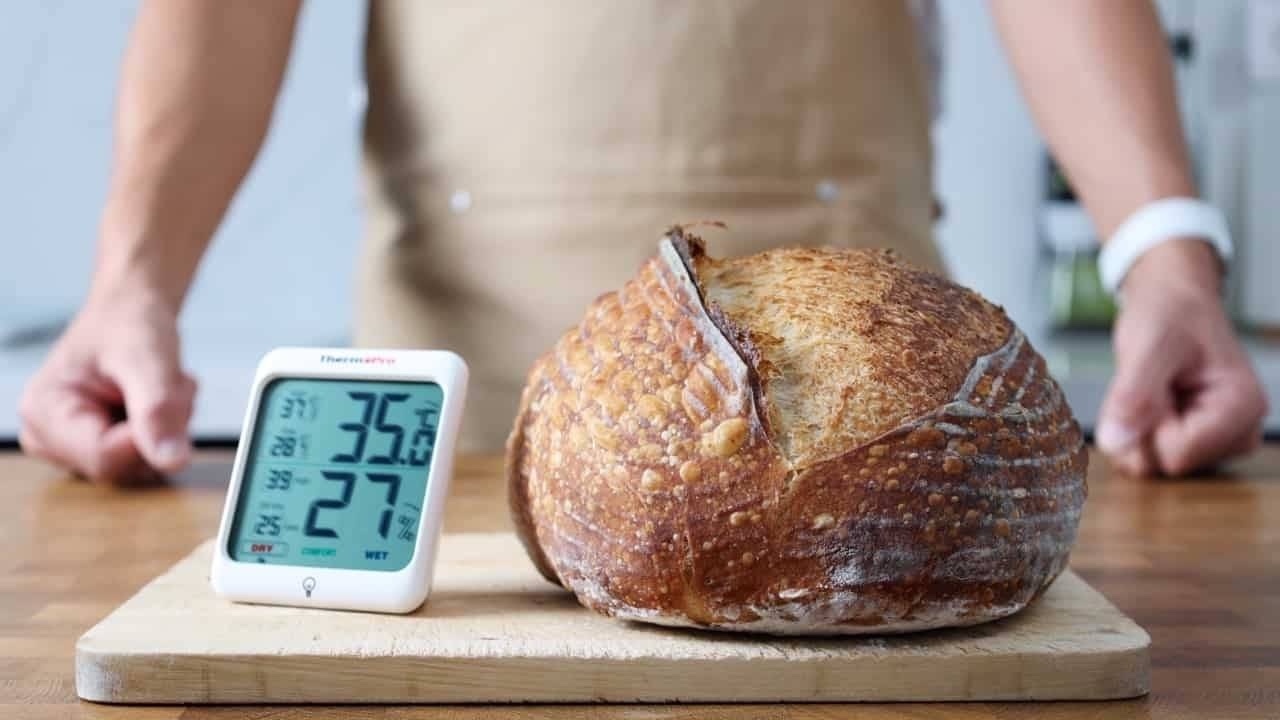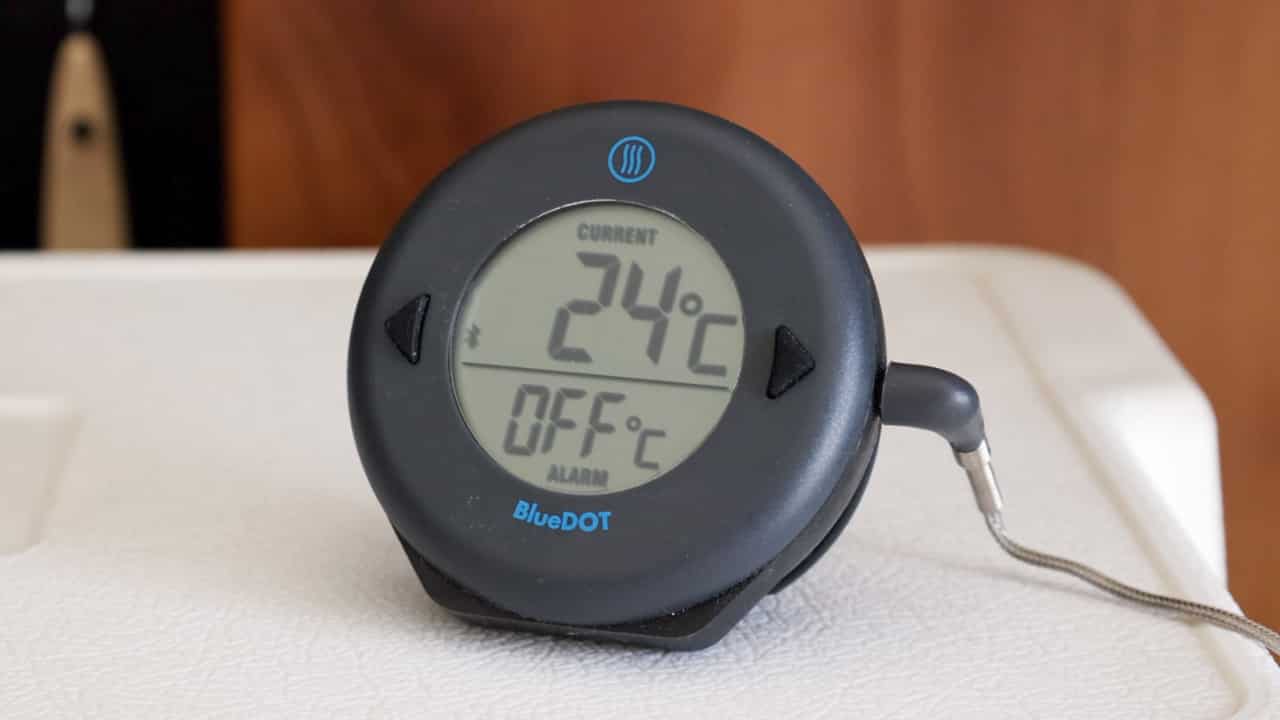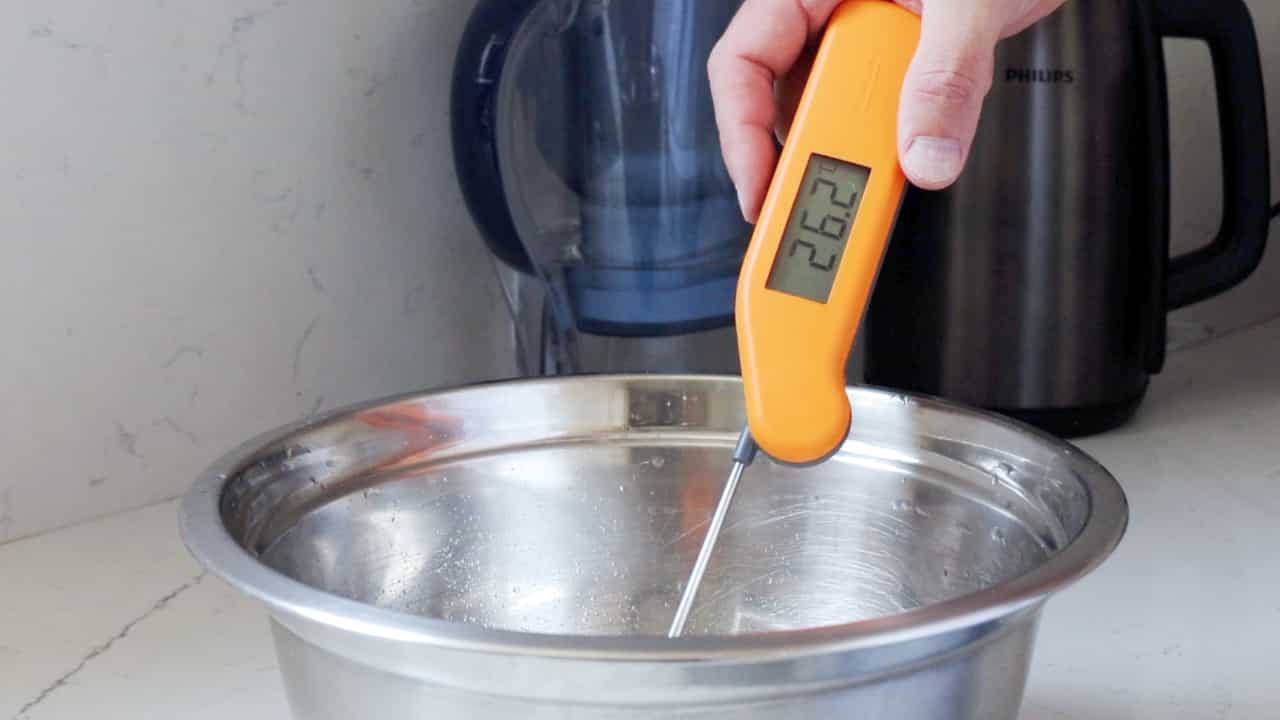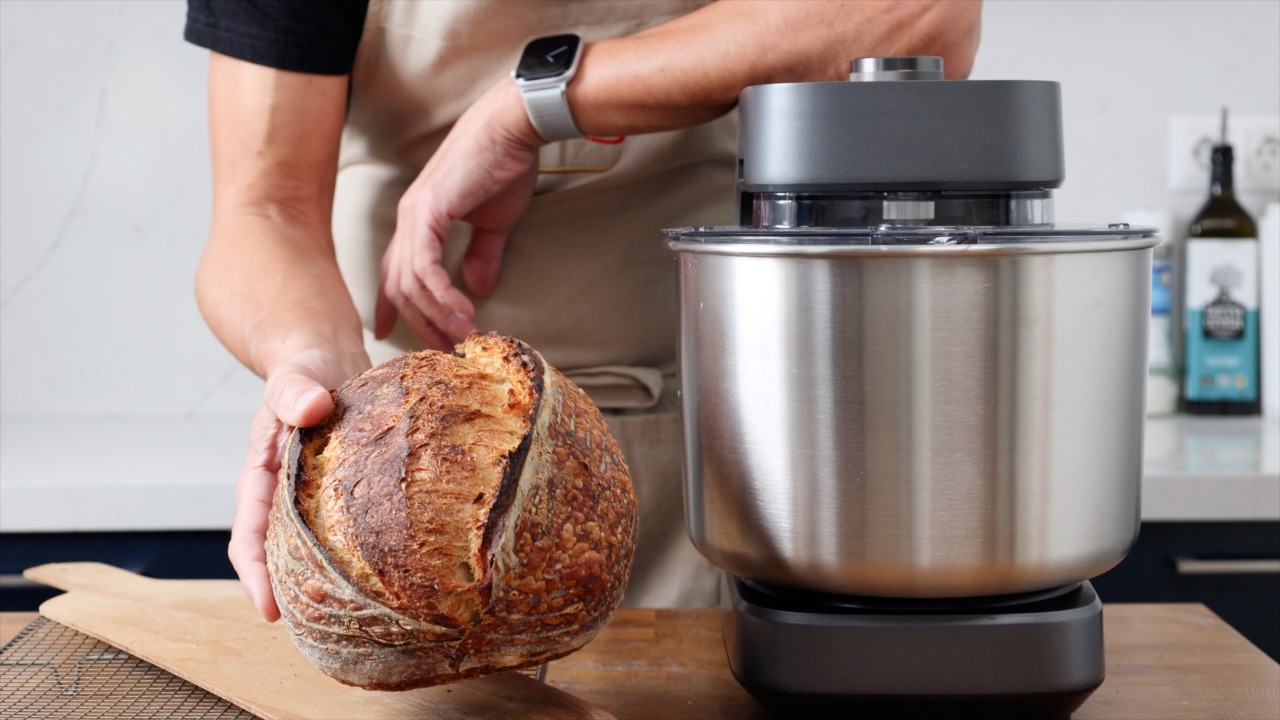Baking Sourdough in Hot Weather

So what’s the short answer to baking sourdough in hot conditions?
Mix your dough to a lower temperature, and place it into a cool box, with an ice brick and a thermometer. The dough will ferment happily in the cool environment avoiding the issues associated with over fermenting in hot weather.
In this blog, I'll dive deeper into how I manage my routine to suit higher temperatures, give you some tactics for dealing with hot weather and how to make a little fermentation box for keeping your sourdough process under control.
Contents:
- What’s the perfect temperature for making sourdough?
- What problems do higher temperatures cause?
- What’s the solution?
- My cool box set-up
- The importance of dough temperature
- Adjusting the recipe to compensate for higher temperatures
- Conclusion
- Watch the video: my top tips for baking sourdough in the summer
- Sourdough & dough temperature calculator
In this blog, I’ll be referencing a levain and sourdough, but these tips refer to any type of pre-ferment or dough.
What’s the perfect temperature for making sourdough?
25 degrees Celsius (77°F) is an excellent temperature to make sourdough, the dough is easy to handle and monitor, and it produces an excellent loaf of sourdough, without the danger of over fermenting.
At this temperature, fermentation occurs at a sensible rate, making scheduling easy. I mix my levain at 22.00 using a 1:7:7 ratio and it will be ready to use for baking the next morning.
Because of the long fermentation period, the levain takes time to ferment and produces a sour but fruity taste, with banana and yoghurt flavours.
How I track the progress of my starter using my sense of smell and taste (Youtube Video)
When I use 10% of levain to inoculate the dough it takes around seven hours to bulk ferment, increasing by seventy-five per cent in size. Because the fermentation period happens relatively slowly the dough isn’t in danger of over fermenting, so it is easy to monitor the process.
After shaping and placing it in the basket the dough takes about two hours to proof before being retarded in the fridge overnight.
The time that each stage takes is well balanced and gives the loaf a sour and fruity flavour. The handling qualities of the dough at this temperature are perfect, it’s not too stiff or too soft which makes stretching and shaping easy.
That’s why 25 degrees Celsius (77°F) is my favourite temperature for making sourdough!
What problems do higher temperatures cause?
When the temperature starts to creep over 30 degrees Celsius (86°F) in my kitchen the sourdough process starts to go too fast for my liking.
My levain becomes more acidic with vinegary flavours and it ferments so quickly I can no longer leave it unattended overnight, which plays havoc with my schedule!
Even with low levels of inoculation the dough bulk ferments too quickly and doesn’t have the time it needs to develop gluten structure. When I turn my dough out of the basket before baking it spreads out over the peel and the scoring becomes more difficult.
The dough becomes trickier to handle during the stretching process and shaping. At 25 degrees Celsius (77°F) a 70% hydrated dough made with strong bread flour handles beautifully, with little or no sticking.
At 30 degrees Celsius (86°F) and above, the dough feels softer and becomes stickier, feeling more like a 75% hydrated dough. So if you are experiencing issues with handling your dough at higher temperatures, you may want to reduce the hydration.
Because the fermentation period goes so quickly it becomes tricky to judge when it's time to shape and start proofing the dough. The window of opportunity is smaller which means the bulk fermentation needs to be continuously monitored so it doesn't overshoot.
If the dough is proofing in its basket at room temperature then there is a real chance it can over ferment so the dough may need to be placed directly into the fridge for cold proofing.
The biggest danger is the dough over-fermenting and becoming too acidic. This will break down the gluten structure in the dough and turn it into a sloppy sticky mess.
The faster fermentation that higher temperatures result in, delivers a different flavour. I lose the well-balanced sour and fruity flavours for harsher vinegary acidic flavours.
What’s the solution?
Create a cooler environment for fermenting your levain and sourdough.
In most cases dropping the temperature by 5-10 degrees Celsius (40-50°F) is all that’s needed, and a cool bag or cool box, with an ice brick, is more than adequate for the job.
You can use any type of insulated container, a cool bag, a cool box, or a polystyrene box. It needs to be big enough to hold your levain, the dough and its container, and an ice brick.
There must be enough room so that the ice brick doesn’t come into contact with your fermentation containers. You can use a kitchen cloth for insulation if necessary.
Choose the right-sized ice brick. I use a 900ml ice brick for my large Igloo chilli bin, 61cm (W) x 37cm (D) x 39cm (H), and a small 150ml ice brick for my cool bag, 28cm (W) x 15cm (D) x 20cm (H).
Remember that the ambient temperature, the size of the ice brick and the temperature of the ferment will impact the temperature you can maintain inside the container. With a little practice, you will find the right balance.
You will need to invest in a thermometer to monitor the temperature and I would suggest one that you can read while the cool bag or cool box is closed.
The Blue Dot BBQ thermometer is perfect for the job. You place the probe in the cool bag or box and leave the unit outside displaying the temperature. It also sends the information over to the app on your phone so you can monitor it (while in range) and look at historical data.
I love the InkBird Wireless Humidity and Temperature Monitor, It’s small and budget-friendly. I use two, one to monitor my kitchen and the other to monitor my fermentation fridge. There is no display though, all of the information is sent to an app on my phone.
You can see all of my temperature control tools on My Baking Kit page. As an Amazon Associate I earn from qualifying purchases.
If budget and space aren’t an issue consider converting a fridge into a fermentation chamber. I experience massive temperature swings here in Greece and as I’m baking near enough every day it made financial sense to invest in this type of project.
How I converted a fridge into a fermentation chamber
My cool box set-up
I used an Igloo Marine cool box successfully for two years before my fermentation chamber was completed.
It has a drain hole situated on the bottom which is great for passing the electrical cable for my heat mat through (after removing the plug). This enables me to use it in the winter to warm the cool box.
During summer I remove the heat mat and use a 900ml ice brick to keep the space cool. As soon as I see the temperature creeping up I switch it for a spare frozen brick.
The chilly bin is large enough to ferment big batches of dough. The more dough I have in the cool box the better it holds the temperature, BUT the dough must be mixed to the target temperature first. More to come on that shortly…
I use either my Blue dot or InkBird to monitor the temperature.
With this set-up, I can easily maintain a temperature around 25 degrees Celsius (77°F). My levain ferments happily overnight and I can complete the bulk fermentation without stressing during the day.
The temperature will fluctuate a little using a set-up like this but it's accurate enough for fermenting sourdough in hot temperatures and is definitely a better option than fermenting at ambient temperatures.

The importance of dough temperature
Let’s say your cool box holds around 25 degrees Celsius (77°F), you would mix your dough to the same temperature, and we call that the desired dough temperature.
The temperature of the room, the flour, the levain and the friction factor are taken using a thermometer. After a simple calculation, the result is the temperature the water needs to be for mixing the dough.
How to calculate desired dough temperature
Let’s say our desired dough temperature is 25 degrees Celsius (77°F).
First, we need to take some temperatures
The temperature of our levain = 28°C
The temperature of our flour = 27°C
The room temperature = 30°C
The friction factor = 0°C (don’t worry about this one, I'll explain more shortly)
We multiply our desired dough temperature of 25°C by four (the amount of temperatures taken above)
25 x 4 = 100
Then we subtract each of the temperatures from 100, the levain at 28°C, the flour at 27°C, the room temperature at 30°C and the friction factor at 0°C.
100 - 28 - 27 - 30 - 0 = 15
15 is the magic number, the water needed to mix the dough should be 15 degrees Celsius (59°F) to achieve our desired dough temperature of 25 degrees Celsius (77°F).
You are going to need a good thermometer for this and I use my trusty Thermapen for this job. It’s accurate, quick, and easy to use.

Friction factor
So what’s the friction factor? That is the amount the dough heats up during the mixing process. This is important if you use a mechanical mixer or spend a long time kneading your dough.
As you will see in my videos, my mixing stage is quick and light, I don’t generate any heat so I keep this at zero.
If you use a mechanical mixer or knead for a long time you can calculate this, don’t worry. You need to make a dough using your preferred method of mixing. Take the temperature at the beginning of mixing and again after mixing is complete. The friction factor will be the difference between the two temperatures.
If you use different methods for mixing dough you will need to record the friction factor for each method and make a note of them to use when you calculate desired dough temperature.
If you want to make your life super easy, feel free to download my sourdough recipe designer which has a dough temperature calculator.
Adjusting the recipe to compensate for higher temperatures
Lastly, let's have a look at the adjustments you can make to the recipe to combat higher temperatures. These are especially useful if you aren’t using a cooler space for your fermentation (although I highly suggest you do!).
Reduce the amount of starter you use when inoculating your levain. If you normally use a 1:1:1 ratio, try using a 1:7:7 (one part starter, to seven parts flour to seven parts water). The lower inoculation will slow down the fermentation and increase the time it takes to ferment.
Using cold water from the fridge to mix your levain will drop the temperature and extend the fermentation time.
Just before your levain has reached its optimum peak, pop it in the fridge to chill. This puts the brakes on the process and can help with scheduling your baking. But there is a bonus, you can use the cold levain to make your dough, helping to reduce the temperature.
Use a smaller amount of levain to inoculate the main dough. In hot weather, or if I want to extend the process I use 10% inoculation.
Using a good quality strong white bread flour which has a protein content of 12% or above will help in developing more strength in the dough.
I’m not a fan of keeping my flour in the fridge, but if your temperatures are exceptionally hot it may help in reducing the temperature of the dough when you mix it.
Reducing the hydration (the amount of water) used in the recipe will also ensure the dough is easier to handle. As I mentioned above, the warmer the dough, the harder it is to handle, reducing the hydration can help with this. If the dough is a touch too sticky try reducing the hydration by 2%, if it's harder to handle, reduce it by 5%. I can’t give you a magic number you’ll need to experiment a little.
Adjusting the recipe in such cases mentioned above can be a little tricky but you are more than welcome to use my sourdough recipe calculator, which makes things super simple!
Conclusion
Find yourself a cheap cool bag or cool box to use as a cool environment for your fermentations. Make sure it is large enough for the amount of dough you need to ferment, you will need enough space to keep the ice block away, or insulated from the container holding the fermentation.
Two ice bricks will be perfect, use one to cool the fermentation space and hold the other one in the freezer so you can swap them over if needed.
Choose a thermometer that allows you to monitor the temperature without opening the lid and letting warm air in. The Blue Dot is a good choice as you can use it for mixing the dough to desired temperatures too.
Mix your dough to lower temperatures, and use smaller amounts of pre-ferment to inoculate your levain and sourdough, both will extend fermentation. A Thermapen is perfect for this job.
Use a good quality strong bread flour. Reduce the hydration if the dough is difficult to handle or sticky.
There is no magic algorithm for baking sourdough. Recipes and formulas take us so far. From there on in, it’s about experimenting and seeing what works best in our own situation.
Keep me posted on how you are getting on in the hot weather! Stay tuned.
Phil
If you enjoyed this blog and would like to support ongoing content creation and help keep the website ad-free, you can click below to make a contribution.
As an Amazon Affiliate, I may earn a commission from qualifying purchases.
Watch the video: my top tips for baking sourdough in the summer




